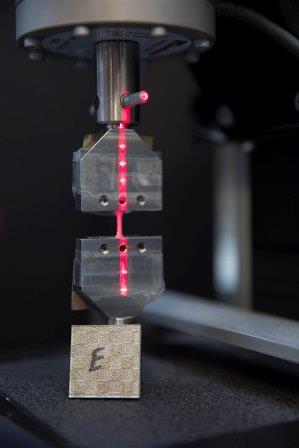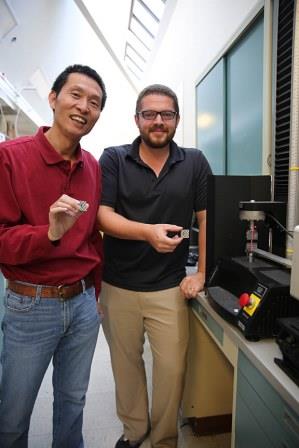Researchers at the Lawrence Livermore National Laboratory (LLNL) (Livermore, California, USA) and several other prominent U.S. institutions say they have achieved a breakthrough in the additive manufacturing (also known as three-dimensional [3-D] printing, where a part is printed or built layer by layer) of Type 316L stainless steel (SS) (UNS S31603), which is often used in marine applications.
According to the researchers, the low-carbon Type 316L SS alloy, valued for its corrosion resistance and high ductility, is a popular choice for products that include oil pipelines, welding metals, kitchen utensils, chemical equipment, medical implants, engine parts, and nuclear waste storage systems.
One usual drawback of coarse-grained Type 316L SS is its low yield strength (~250 to 300 MPa), the researchers note, adding that many traditional metallurgical routes to strengthening the material, such as cold rolling or forging, often come at the expense of tensile ductility. However, they believe a new discovery could soon change that equation—and it may extend to other lighter-weight alloys as well.
Usual Limits of Strengthening
According to Morris Wang, LLNL materials scientist and lead author of a study on the subject, 3-D printing shows promise as a superior alternative to traditional strengthening techniques.1
 “In order to make all the components you’re trying to print useful, you need to have this material property at least the same as those made by traditional metallurgy,” Wang says. “We were able to 3-D print real components in the lab with 316L stainless steel, and the material’s performance was actually better than those made with the traditional approach. That’s really a big jump. It makes additive manufacturing very attractive and fills a major gap.”
“In order to make all the components you’re trying to print useful, you need to have this material property at least the same as those made by traditional metallurgy,” Wang says. “We were able to 3-D print real components in the lab with 316L stainless steel, and the material’s performance was actually better than those made with the traditional approach. That’s really a big jump. It makes additive manufacturing very attractive and fills a major gap.”
Wang acknowledges that several engineered gradient microstructures with spatial variations of either grain size or twin spacing were developed in recent years with both high strength and ductility. However, he says these approaches typically require tooling or mechanical surface treatment, which is difficult to apply to the complex geometrical components necessary for practical use.
In contrast, the laser powder-bed fusion (L-PBF) technique used by Wang’s team can print materials and parts directly from a computer-aided design file, which offers unique design advantages without the need for specialized tools or equipment.
Wang believes the methodology could open the floodgates to widespread 3-D printing of SS components, particularly in the aerospace, automotive, and oil and gas industries, where strong materials are needed to tolerate extreme force in harsh environments.
Laser Melting Technique
In the past, the 3-D printing of high-quality metals has been limited by the porosity caused during the laser melting, or fusion, of metal powders. This process has often caused parts to degrade and fracture easily, according to the researchers. In response, they have developed a density optimization process for their L-PBF technique that involves experiments and computer modeling, which enables them to manipulate the materials’ underlying microstructure.
“This microstructure we developed breaks the traditional strength-ductility tradeoff barrier,” Wang says. “For steel, you want to make it stronger, but you lose ductility essentially; you can’t have both. But with 3-D printing, we’re able to move this boundary beyond the current tradeoff.”
Using two different L-PBF machines, researchers printed thin plates of Type 316L SS for mechanical testing. The laser melting technique inherently resulted in hierarchical cell-like structures that could be tuned to alter the mechanical properties, the researchers say.
 “The key was doing all the characterization and looking at the properties we were getting,” says LLNL scientist Alex Hamza, who oversaw production of some additively manufactured components. “When you additively manufacture 316L SS, it creates an interesting grain structure, sort of like a stained-glass window. The grains are not very small, but the cellular structures and other defects inside the grains that are commonly seen in welding seem to be controlling the properties. This was the discovery.”
“The key was doing all the characterization and looking at the properties we were getting,” says LLNL scientist Alex Hamza, who oversaw production of some additively manufactured components. “When you additively manufacture 316L SS, it creates an interesting grain structure, sort of like a stained-glass window. The grains are not very small, but the cellular structures and other defects inside the grains that are commonly seen in welding seem to be controlling the properties. This was the discovery.”
Since L-PBF is a layer-by-layer build technology, it allows ample opportunities for users to tailor the microstructure and subsequent mechanical properties, they explain. Tensile tests of samples show that the L-PBF generated 316L SS has high yield strengths that are two to three times stronger than those made from traditional methods. In addition, tests have shown a steady strain-hardening ability at high stress levels, which leads to a uniform tensile elongation that surpasses conventional Type 316L SS.
“The highly localized melting, strong temperature gradient, and high solidification front velocity associated with L-PBF processes generate extremely non-equilibrium microstructures that are not accessible through conventional methods,” Wang writes in the study.2
Applicable to Other Metals
Thomas Voisin, an LLNL post-doctoral researcher, has performed characterizations of 3-D printed metals since joining LLNL in 2016. He believes the research could provide new insights on the structure-property relationship of many additively manufactured materials, including some beyond SS.
“Deformation of metals is mainly controlled by how nanoscale defects move and interact in the microstructure,” Voisin says. “Interestingly, we found that this cellular structure acts such as a filter, allowing some defects to move freely and thus provide the necessary ductility while blocking some others to provide the strength. Observing these mechanisms and understanding their complexity now allows us to think of new ways to control the mechanical properties of these 3-D printed materials.”
The researchers say their ultimate goal from the project is to use computational analysis to validate and predict the future performance of metals while using models to control the underlying microstructure.
According to Wang, the SS breakthrough could serve a “surrogate material” system that could be used for other types of metals—particularly with lighter-weight alloys that are more brittle and prone to cracking.
The work took place over several years and required contributions from collaborators at the Ames National Laboratory (Ames, Iowa, USA), which used x-ray diffraction to better understand the performance of materials.
Oregon State University (Corvallis, Oregon, USA) facilities were used for characterization and composition analysis, while researchers at the Georgia Institute of Technology (Atlanta, Georgia, USA) performed modeling to understand how the material could have both high strength and high ductility.
Source: LLNL, www.llnl.gov. Contact Morris Wang, LLNL—email: ymwang@llnl.gov.
References
1 “Lab Researchers Achieve Breakthrough in 3D Printed Marine Grade Stainless Steel,” LLNL News Releases, Oct. 30, 2017, https://www.llnl.gov/news/lab-researchers-achieve-breakthrough-3d-printed-marine-grade-stainless-steel (Dec. 11, 2017).
2 Y. Morris Wang, et al, “Additively Manufactured Hierarchical Stainless Steels with High Strength and Ductility,” Nature Materials, Oct. 30, 2017, https://www.nature.com/articles/nmat5021 (Dec 11, 2017).